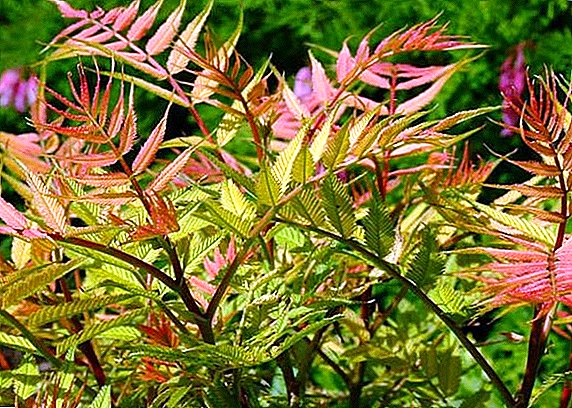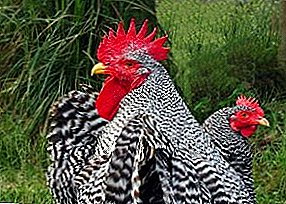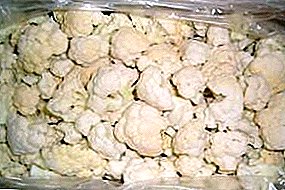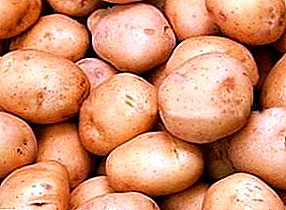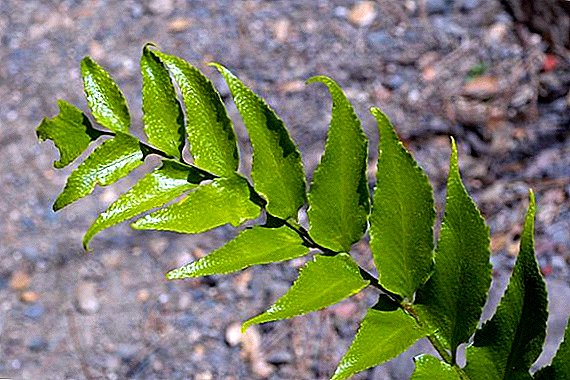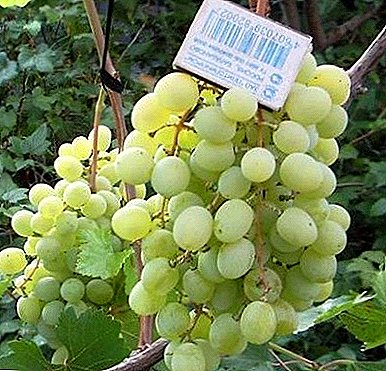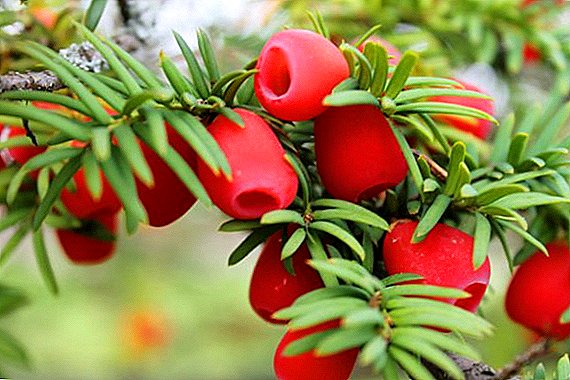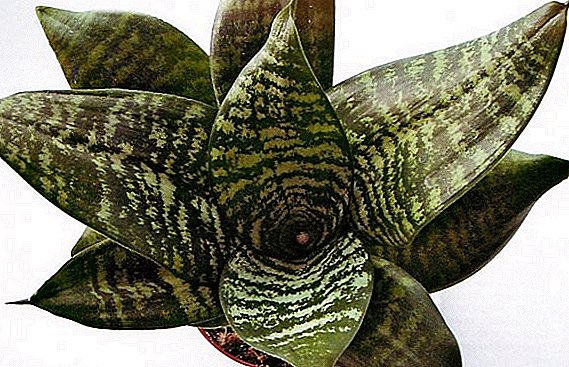 Sansevieria combines 60-70 species of evergreen stemless plants of the Agave family. The plant owes its Latin name to the Neapolitan prince San Severo, who promoted the development of the natural sciences.
Sansevieria combines 60-70 species of evergreen stemless plants of the Agave family. The plant owes its Latin name to the Neapolitan prince San Severo, who promoted the development of the natural sciences.
In nature, the plant grows in the tropical regions of Asia and Africa and, thanks to its attractive appearance and unpretentiousness, has earned the love of gardeners. In Sansevieria, all species can be divided into two types of leaves: with flat and thick leaves.
Three-lane Sansevieria (Sansevieria trifasciata)
 A plant with flat oval leaves, often referred to as "pike tail". Leaves grow from the root zone. They are dark green in color, separated by light transverse stripes. In the outlet they are usually up to 6 pieces.
A plant with flat oval leaves, often referred to as "pike tail". Leaves grow from the root zone. They are dark green in color, separated by light transverse stripes. In the outlet they are usually up to 6 pieces.
The size of the sheet in length is 30-120 cm, in width - 2 - 10 cm. The leaf is oval in shape, smooth, at the end it ends with a point. The intensity of the color of the leaves depends on the illumination of the room.
Three-lane Sansevieria is a common indoor plant and is distinguished by its unpretentiousness. Often it is used as a floor indoor flower. It is well tolerated by any light, but it is better to keep it in bright light.
It is rarely necessary to water the plant, since it stores water in its tissues. Keeping indoors with central heating is comfortable for the plant. The preferred humidity should be low, because the plant is adapted to the dry air of the savannas.
The flower is rather afraid of excess moisture, so the soil between watering should dry out. If the leaves turn yellow, it is necessary to reduce watering. Other reasons simply can not be.
The plant is sensitive to temperatures below 14 ° C, but it tolerates temperature fluctuations and drafts well. The most comfortable temperature is 20-32 ° С. The lower the temperature, the less watering should be.
Repot the plant in the spring, if the roots have filled the entire volume of the pot. This usually happens once every 2-3 years. For transplantation, use loose universal substrates, adding 30% of sand. The most suitable substrate for cacti.
Important! The root of the plant is so powerful that it can crush the pot.
 Propagated by plant division or leaf cuttings. The most common is division.
Propagated by plant division or leaf cuttings. The most common is division.
To do this, you need to remove the entire plant from the pot along with the earthy clod and with the help of a knife cut thick roots into pieces that will contain a sheet rosette of the plant. The separated parts easily take root because they have many small rhizomes.
Reproduction by cuttings more labor intensive. The length of the cutting from a healthy leaf should be no less than 5 cm. Before planting in the sandy soil, they are kept slightly in the air, and then treated with a root growth stimulator. Roots are formed in about a month.
Important! Sansevieria refers to poisonous plants, so do not keep it in rooms where children are. Wash your hands after working with a flower.
When feeding the sanceverier, you must use fertilizer for cacti. Feeding is necessary to carry out only during the growing season.
Sansevieria is not subject to disease. Improper care can lead to rotting of the roots, resulting in mealybugs, spider mites or scythosis.
This plant is a good indoor air purifier. It absorbs 107 types of toxins from the environment and releases oxygen.
Did you know? Sansevierii indoors reduce the number of pathogens: staphylococci by 30–40%, sarcins by 45–70%, streptococcus by 53–60%. The plant can absorb nicotine.
From the original species, many varieties of sansevieri were cultivated, which differ in the size, shape of the leaf and its color. Let's call the main types of pike tail:
- Sansevieria Laurenti (Sansevieria trifasciata "Laurentii") has dark green leaves with transverse gray-green stripes in the center and yellow at the edges;
- Sansevieria Compact (Sansevieria trifasciata "Laurentii Compacta") is a descendant of the Laurenti variety, but is distinguished by wide, short leaves. Species characteristics are preserved only when dividing rhizomes;
- Sansevieria Nelson (Sansevieria trifasciata "Nelsonii") comes from the Laurenti variety and has dark green leaves with a velvety shine that grow strictly upwards. The leaves differ from the original variety in that they are shorter, thicker and more numerous. Saves species characteristics only when dividing a plant;
- Senseishin Bentle (Sansevieria trifasciata "Sensation Bantel") comes from the Laurenti variety. The leaves are slightly shorter, but have white longitudinal stripes on dark green leaf plates;
- Hansei Sansevieria (Sansevieria trifasciata "Hahnii") is distinguished by short back-curved leaves of dark green color and a vase-like shape. Golden Hahni is characterized by the presence of a yellow band, and Silver Hahnii is characterized by silvery gray-green foliage;
- Sansevieria Futura (Sansevieria trifasciata "Futura") has wider and shorter leaves than Laurenti;
- Robusta Sansevieria (Sansevieria trifasciata "Robusta") has a leaf size, like that of the Futura variety, but without yellow stripes on the edge of the leaf plate;
- Munsein Sansevieria (Sansevieria trifasciata "Moonshine") with leaf size, as in the Futura variety, but the leaves are gray-green, silver in color.


Big Sanseviera (Sansevieria grandis)
Sansevieria large characterized as a stemless plant with a fleshy rosette consisting of 2-4 sheets. The leaf shape is oval and has the following dimensions: 30-60 cm long and 15 cm wide.
The color of the leaves is light green with dark cross lines and a red border around the edge. The height of the peduncle is up to 80 cm, the flowers are white with a green tinge, and are collected in a dense racemose inflorescence. 3-4 leaves are placed on the peduncle. The plant belongs to the epiphytic. 
Did you know? Sansevieri leaves contain abamagenin, organic acids, sapogenin. At home, the plant is used as a medical. His juice is treated stomach ulcer, gynecological diseases, inflammation of the middle ear. The decoction is used for general weakness and itchy skin.
Hyacinth (Sansevieria hyacinthoides)
 Hyacinth Sansevieria reaches a height of up to half a meter. The leaves are placed in a bundle of 2-4 pieces, their sizes up to 45 cm long and 3-7 cm wide. They have a green color with light transverse strokes, the edges may be brownish or whitish.
Hyacinth Sansevieria reaches a height of up to half a meter. The leaves are placed in a bundle of 2-4 pieces, their sizes up to 45 cm long and 3-7 cm wide. They have a green color with light transverse strokes, the edges may be brownish or whitish.
Strong roots. The plant blooms in winter with small flowers placed on the peduncle up to 75 cm high. The smell of flowers is fragrant.
Dunery (Sansevieria dooneri)
 Sansevieria Dunery characterized by a lush outlet, consisting of 10-12 sheets. The leaves are flat, green, with transverse dark green stripes. Their sizes: length is about 25 cm and width is up to 3 cm.
Sansevieria Dunery characterized by a lush outlet, consisting of 10-12 sheets. The leaves are flat, green, with transverse dark green stripes. Their sizes: length is about 25 cm and width is up to 3 cm.
Short shoots are located on the rhizome. Root thickness 6-8 mm green. The plant belongs to the flowering. On the peduncle up to 40 cm long there are white flowers collected in the racemes. The smell of flowers resembles lilac.
Liberian Sansevieria liberica
 Liberian Sansevieria characterized by flat leaves that form rosettes of 6 sheets and are placed almost parallel to the ground. Sheet plate size: 35 cm long and 3-8 cm wide.
Liberian Sansevieria characterized by flat leaves that form rosettes of 6 sheets and are placed almost parallel to the ground. Sheet plate size: 35 cm long and 3-8 cm wide.
The color of the leaves is dark green with light green touches. The edge of the leaf is whitish-red. On the rhizome formed daughter outlets. Peduncle up to 80 cm high, on it are white flowers, collected in a racemes. The smell of flowers is sharp.
Kirk (Sansevieria kirkii)
 Kirk Sansevieria characterized by long leaves up to 1.8 m in height, collected by 1-3 pieces in the outlet. The color of the leaves is green with whitish spots, and the edges have a red-brown edging.
Kirk Sansevieria characterized by long leaves up to 1.8 m in height, collected by 1-3 pieces in the outlet. The color of the leaves is green with whitish spots, and the edges have a red-brown edging.
The underground rhizome of the plant is short. This variety has white flowers, collected in capitate inflorescence. Sansevieria kirkii var. Pulchra is a species of this species. Its feature are red-brown leaves.
Graceful Sansevieria (Sansevieria gracilis)
 Perennial plant with a stem height of 5-6 cm. The length of the leaves up to 30 cm, they completely cover the stem. The sheet plates are oval-shaped, gray-green in color with transverse stripes, forming a tube towards the end. Scions form near the base of the stem.
Perennial plant with a stem height of 5-6 cm. The length of the leaves up to 30 cm, they completely cover the stem. The sheet plates are oval-shaped, gray-green in color with transverse stripes, forming a tube towards the end. Scions form near the base of the stem.
Cilindrika (Sansevieria cylindrica)
A perennial plant that does not have a stem, but is characterized by long, up to one and a half meters, leaves folded into a tubule. The color of the leaves is dark green with longitudinal strokes. Sheet plate width up to 3 cm.
Peduncle reaches a height of 1 m. The flowers are milky-white with pink tips, gathered in a racemose. There are interesting varieties of this species that retain the characteristics of the main plant:
- Sansevieria cylindrica "Sky line" - leaves grow in parallel and have the shape of a hand with fingers apart, pointing to the sky.
- Sansevieria cylindrica "Midnight Star" - leaves are oval, dark green, have thin vertical lines.
- Sansevieria cylindrica "All night star" - leaves are much shorter and grow in all directions, creating a star shape.
- Sansevieria cylindrica "Patula" - leaves grow left and right, slightly curving down. The lamina has no channel and is painted with transverse green stripes.




